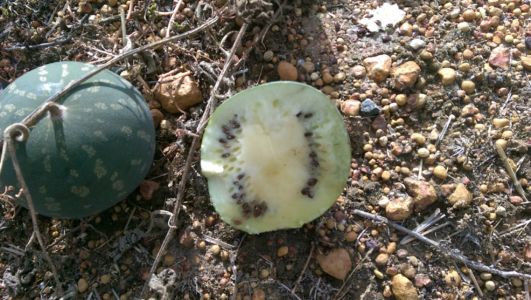Scientific Name: Citrullus lanatus (Thunb.) Matsum. & Nakai var. lanatus
Citrullus Lanatus, also known as the Afghan melon, bastard melon, bitter apple, bitter melon, camel melon, colocynth, kaffir melon, mickey melon, paddy melon, pie melon, watermelon, white watermelon, wild melon, wild watermelon.

Very closely related to the watermelon which is Citrullus lanatus var. Caffer or Citrullus lanatus var. lanatus. Many people refer to the plant as a paddy melon, but this is a misnomer; the Cucumis myriocarpus (Paddy Melon) has smaller fruit, a denser habit and brighter leaf colour.
Scientific Name: Cucumis myriocarpus Naudin
Also known as (gooseberry cucumber, gooseberry gourd, paddy melon)
Cucumis is the Latin name for cucumber, a close relative of prickly paddy melon.
Myriocarpus is from the Greek myrias or Latin myrio meaning many and Greek karpos or Latin carpa meaning fruit referring to the abundant fruit production on the plant.
Prickly refers to the soft spines on the fruit. Paddy is of uncertain origin, and is locally attributed to ‘Paddy’ the typical Irishman who grew them believing they were edible.
Cucumis myriocarpus (prickly paddy melon) is often confused with Citrullus lanatus (the Afghan or camel melon) in Australia, where both species are introduced.
Cucumis myriocarpus has many small fruit, hidden under the leaves. The fruit are smaller than a golf ball and yellow-green or green-striped in colour with soft spines, developing to yellow on maturity.
The larger melons commonly seen on roadsides in rural Australia are in fact Citrullus lanatus, a wild relative of the watermelon.
The fruit and foliage are toxic due to the presence of cucurbitacin. The plant is potentially toxic to horses, sheep, cattle and pigs and has been associated with stock deaths. It has been used by humans as an emetic (induce vomiting) and there are records of poisoning occurring in humans.

Mature fruit
For further information:
http://www.herbiguide.com.au/Descriptions/hg_Prickly_Paddymelon.htm



